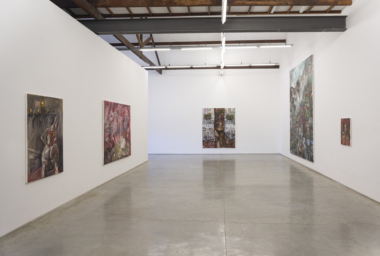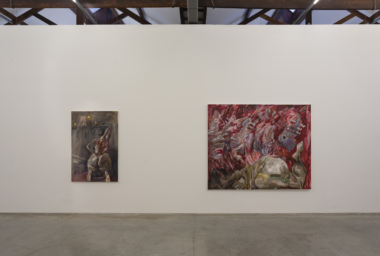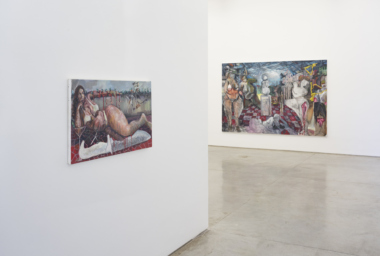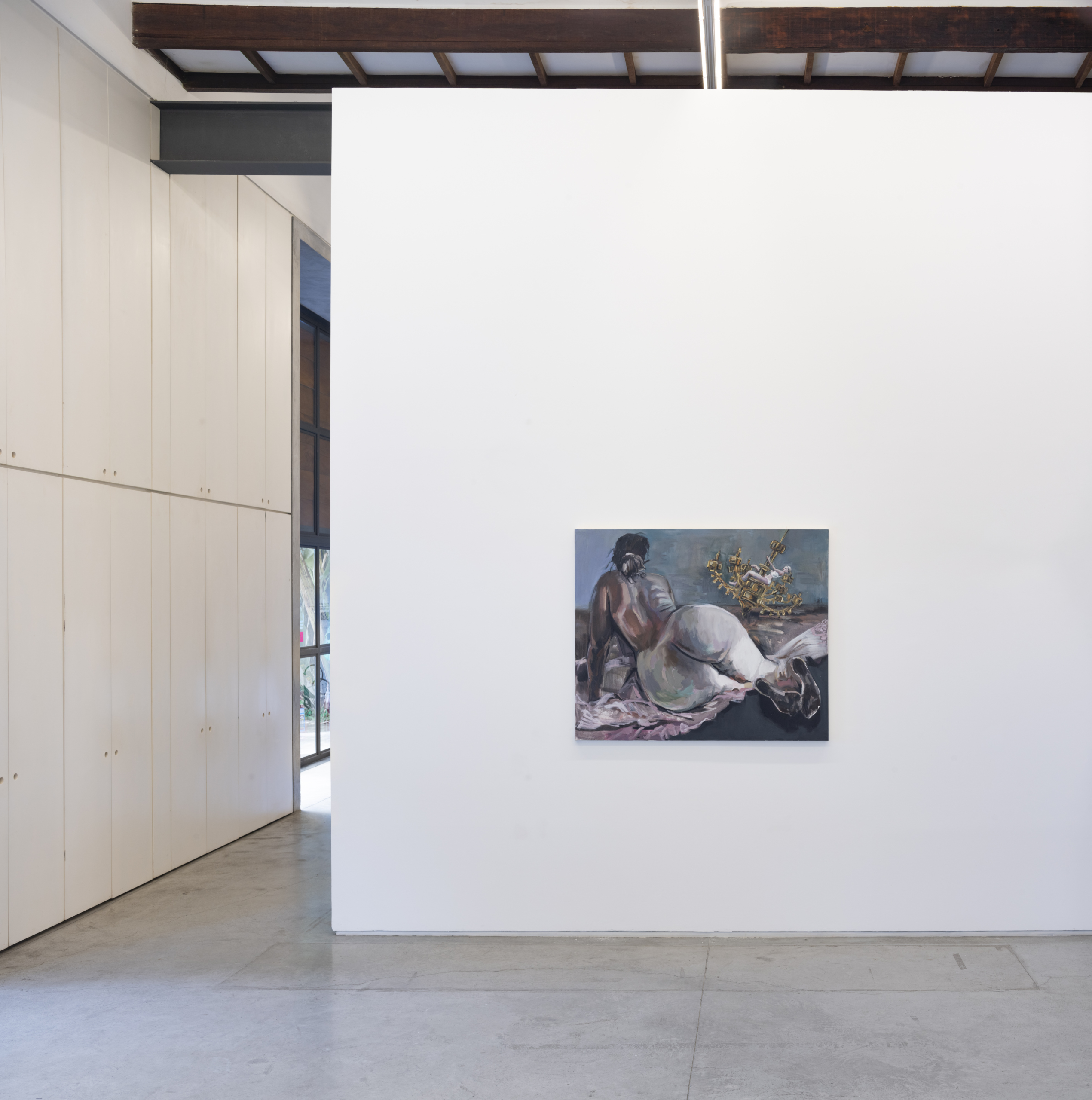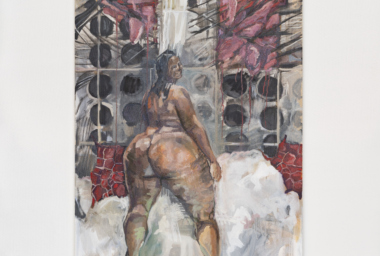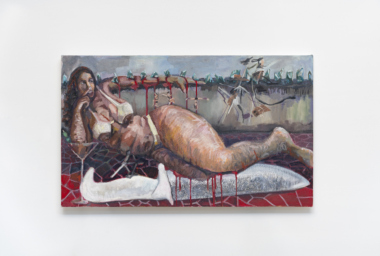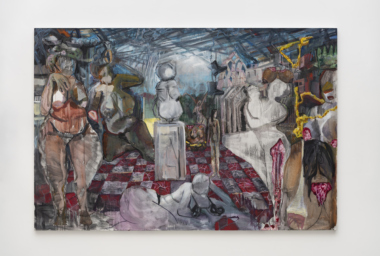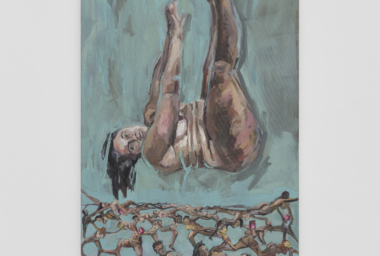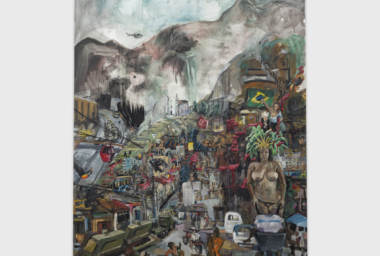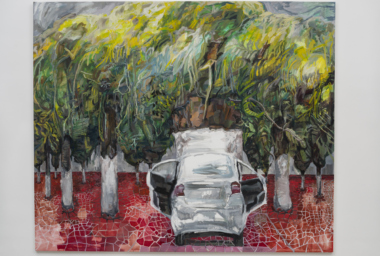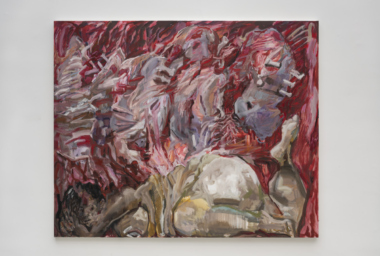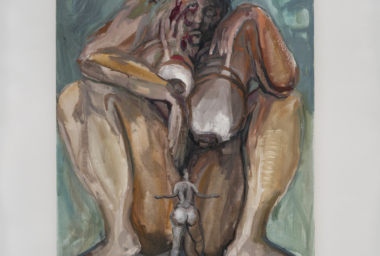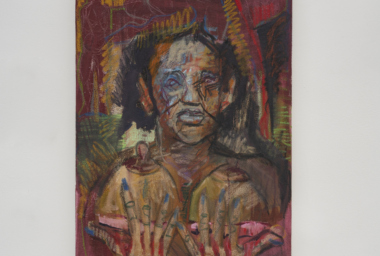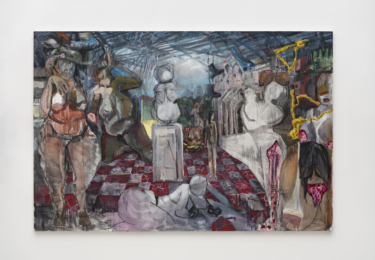
Márcia Falcão
Nov 6, 2021 – Jan 29, 2022
Opening
Nov 6, 12 pm–6 pm
Carpintaria
Rua Jardim Botânico 971,
Rio de Janeiro
Directions
Download
We are thrilled to announce Márcia Falcão’s first solo exhibition. Emphasized by gesture and physicality, her painting articulates relations between the female body and the city, based on the artist’s own experience in the suburbs of Rio de Janeiro, where she was born, lives, and works. The artist’s figurative compositions present a gloomy palette commanded by shades of brown and red and thickened by the use of oil, acrylic, oil pastel, and charcoal, with a greater impasto in specific regions. Brimming with an ethos of violence, between expressions and a strong narrative impulse, a painting with a distinct visual impact emerges.
Red Tile Fragments
By Raphael Fonseca
When looking at Márcia Falcão’s recent paintings, perhaps the one element that draws the spectator’s attention most is the floors onto which her narratives unfold. They are often red and fragmented as if we were looking at the representation of a mosaic of irregular pieces of red tile. To some extent, her paintings evoke a type of paving commonly seen in the outskirts of Rio, particularly in the neighborhood where the artist grew up: Irajá. This architectural element, however, is not only found in that area but all over Brazil – from 1940s São Paulo to the so-called raio-que-o-parta architecture in Belém do Pará. In fact, the artist’s painting moves in the same way, between what can be seen as specific and local and a wider sphere that invites multiple reflections.
The series of police invasions that took place in the neighborhood of Morro do Alemão, in Rio de Janeiro, are the departure point for the monumental painting which is the centerpiece of Falcão’s solo exhibition. Here, in a patchwork of fast brushstrokes, which give shape to the mountains and to some of the figures at the bottom of the image, our eyes are drawn to a number of elements, such as a helicopter, a tram, a red flag and a Brazilian flag emerging like a ghost in Delacroix’s Liberty Leading the People (1830). We also see the figure of a melancholy looking woman who gazes at the spectator – she is Black and her body is curvaceous, on her head she carries a Carnival-like green and yellow crown.
Here, the ‘Brazilian woman’ – an idea that has been sexualized, objectified, and stereotyped by hundreds of authors in visual arts and mass culture – is not covered in glitter, nor is she dancing samba to the sound of old Carnival tunes like Lá vou eu, lá vou eu/hoje a festa é na avenida [Here I come, here I come/today the party is on the streets]. The work of Márcia Falcão suggests instead a constant tension between pleasure and violence, between the Carnival on the streets and the violence that afflicts so many women. Far from pointing the finger, these images personify the contradictions of being alive in Rio de Janeiro, in Brazil or anywhere else in the world.
The body that appears in Moça reclinada no fio do facão: presa em casa [Lady Reclined on a Big Knife Edge: Locked Up at Home] (2021) refers to the artist’s own body, which can also be seen in other works that, on a smaller scale, present situations that are more concise. Lying down between the red floor and the knife-edge, a woman is bleeding, and the liquid is running towards the bottom of the canvas. Her arm is leaning against a wall full of glass shards, something typically seen in many neighborhoods of Rio de Janeiro as a device to protect the space of private homes. The domestic space suggested by Márcia Falcão seems to be the realm of solitude, conflict and minor violence. In Cacos internos, dores expostas [Internal Shards, Exposed Pains] (2021), a woman appears to be opening up her back to show her insides, whilst in Esconderijo e cela [Hideout and Cell] (2021), the same figure is lying down surrounded by an area filled with brushstrokes of a deep red that seem to torment her. Bit by bit the artist suggests an inventory of uncomfortable situations that encircle her characters – or herself?
It is interesting to note how the artist’s dripping brushstrokes engender a space of uncertainty. What could that succession of reds be? Perhaps a reference to flesh and blood? Could the black lines that appear at the top of some paintings be referring to the entanglement of wires and illicit connections that we also find in Rio de Janeiro? Far from answering everything at the same time, the artist is interested in offering us one of her dearest things in life – painting and its ability to create details without closed meanings. Therefore, unlike many painters from her generation, who have produced explicit and folkloric images around the idea of the ‘periphery’, Márcia Falcão has one foot in Irajá and the other anywhere else she would like to go. As Beyoncé would say ‘I’m a grown woman / I can do whatever I want’.
Lastly, Ensaio sobre 80 tiros e cal a meio tronco [Essay on 80 Shots and Lime Wash on Half Trunk] (2021) captivates for its lack of a human body. The work evokes a recent event that shook the country: the 80 shots fired by the army against the car of a Black family in Rio de Janeiro. In the image – which strikes an unusual conversation with the tragic event – we see a series of tree trunks half-painted with white lime wash. In an exchange with the artist, she mentioned how she understood – through accounts from family members and neighbors – the racism behind this practice: by painting tree trunks in white, homeowners could supposedly easily spot if a Black person was roaming outside their properties at night.
The painting, therefore, brings together different narratives that deal with racism in Brazil – the spectacle of violence walks side by side with the traditions that make up a place’s culture. Instead of drawing on the representation of blood to depict tragedy in Rio de Janeiro, Márcia Falcão opts to bring back the popular type of paving made of red broken tile fragments. Why would you need blood when you can produce a reddening boiling area to evoke calamity via the image’s own drama?
Be it in her allegories of urban violence or in her sharp gaze towards the many forms of solitude imposed on Black women – particularly mothers, like herself – Márcia Falcão invites us to join up the pieces of her narratives. For the artist, painting is a way of giving meaning to existences that are wrecked. Just like life, something will always be missing. In the meantime, we can gather the fragments of her red floors and learn about the stories that her paintings are telling us.
Márcia Falcão (Rio de Janeiro, 1985) lives and works in Rio de Janeiro. Among her group exhibitions, the following stand out: Crônicas Cariocas, MAR — Rio de Janeiro Art Museum (Rio de Janeiro, 2021); Engraved into the body, Tanya Bonakdar Gallery (New York, 2021); Hábito/ Habitante, Escola de Artes Visuais do Parque Lage (Rio de Janeiro, 2021); Ainda fazemos coisas em grupo, Centro Municipal de Artes Hélio Oiticica (Rio de Janeiro, 2020); 12 Métodos de ser chegar a lugar algum, Paço Imperial (Rio de Janeiro, 2019); e Mostra EAV Parque Lage, Escola de Artes Visuais do Parque Lage (Rio de Janeiro, 2018).


